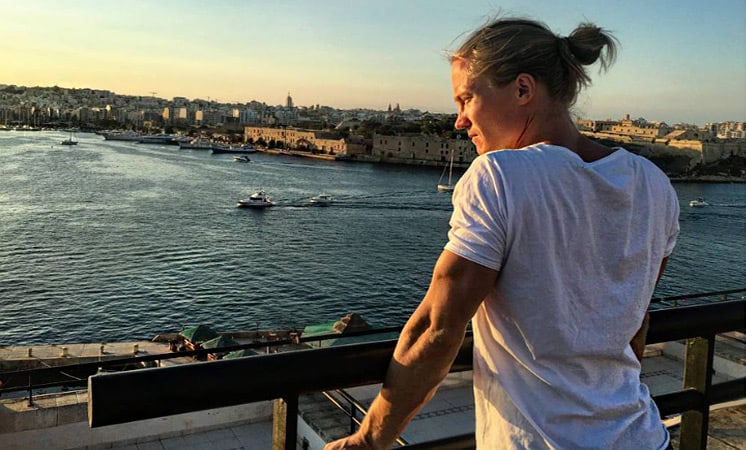
Traveling is awesome and so is getting a ripped physique! But one thing that makes me a bit sad is when people say that you can’t have both, that you can’t travel and get ripped at the same time.
In this post I’m going to explain why this simply isn’t true and what you should do to successfully get ripped while traveling.
So, how to get ripped while traveling? Getting ripped while traveling isn’t much different from getting ripped at home. The only difference is that you must set up your diet and training in a way that supports a ripped physique with the tools and strategies available to you during your travel.
Read on to learn more about these tools and strategies and how you should set them up to successfully build a ripped body while traveling.
Table of Contents
How to Set Your Diet While Traveling
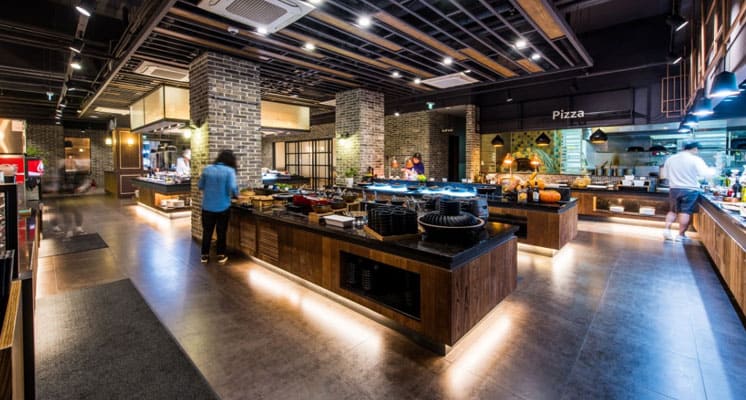
Diet is at least 50% of the equation when it comes to building a ripped physique. The problem when traveling is that sticking to a diet that will help you build a ripped physique can be a bit trickier than what it would when you’re at home.
However, I wrote trickier, not impossible. So, here’s what to do:
Step 1 – Make Sure You’re in a Calorie Deficit or Surplus
This is the most important step when it comes to your diet. No matter where you are or what you’re doing, the quickest way to build a ripped physique is to utilize bulking and cutting cycles.
So, my recommendation is that, even when you’re traveling try your best to be in either a calorie deficit (if you need to get lean) or a calorie surplus (if you need to add muscle), and then you cycle between these two by staying within the 8-15% body fat range.
Sure you could just eat at maintenance calories and slowly do a “body recomposisition”, but it’s been shown over and over again that doing so is an incredibly slow process towards building a ripped physique. So, if you’re interested in getting ripped sooner rather than later, stick with the bulking and cutting strategy.
If you want to learn how to set up your bulks and cuts, read these posts next:
Step 2 – Eat Enough Protein
This is the second most important step when it comes to the diet. Making sure that you get around 0.8-1 gram per lb (1.8-2 grams per kg) of bodyweight of protein per day both when bulking and cutting will ensure that you build/maintain your muscle mass.
You don’t have to worry as much about your carbs and fats as they’re not nearly as important as your protein intake when it comes to building your physique. Just make sure you hit your calories and protein, and just allow your carbs and fats to end up where they do depending on what you’re eating during the days.
If you want to learn more about setting up your protein intake, watch this video:
How to Track Calories & Protein When Traveling
Okay, so let’s talk about the actual trickiness of dieting when traveling, which is how to actually make sure you’re eating the correct amount of calories and protein.
The struggle when traveling is that it’s not as easy to prepare pre-calculated meals that you can stock up in bulk in your refrigerator and have readily available throughout the week, which is the preferred method for a lot of people when they diet at home.
And even if you live in an appartment or an Air BnB and could prepare your meals and stock them up in this way, I must agree that it’s not a particularly fun way to dine when you’re traveling, and it’s not something that I presonally do when I’m traveling.
So, what’s the alterantive?
Well, to become best buddy with an app like MyFitnessPal!
Learn How to Track Calories & Protein Using MyFitnessPal
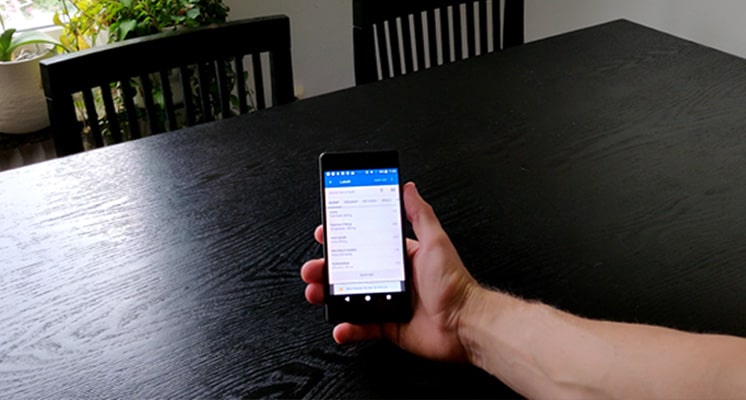
Learning how to track calories and protein using the MyFitnessPal app on my phone is hands down the best thing I’ve learned when it comes to dieting. With this knowledge I’m able to stick to my calories and protein to successfully achieve the physique of my dreams even while I’m traveling.
I can step into most big restaurant chains like Subway, Chipotle and Taco Bell etc. and order a decently healthy meal, add it to MyFitnessPal and directly see how much calories and protein I’ve consumed and how much I have left for the day.
How to Use MyFitnessPal:
Inside MyFitnessPal you have a food database that people all around the world adds to the app. All you need to do is search up the food that you’re going to eat:
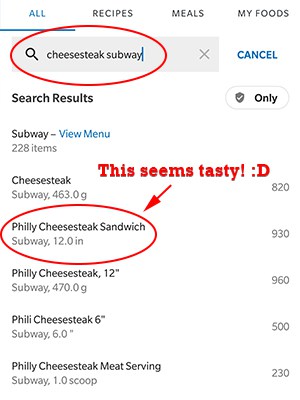
Then it’s just a matter of hitting your calories and protein consistently over your days, weeks and months. This specific meal included 930 calories and 50 grams of protein:
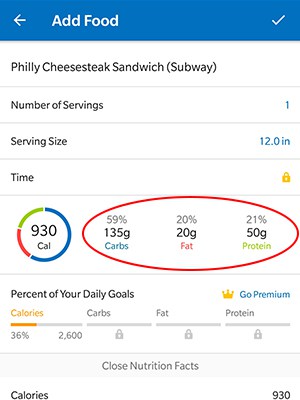
This works if you’re eating from “mom and pop” restaurants as well. However it’s a bit trickier to do since MyFitnessPal won’t always have all the foods from “mom and pop” restaurants added in it’s library. If this is the case you need to guestimate how much calories and proteins that you have on your plate.
How to Guestimate The Calories & Protein From Mom and Pop Restaurants
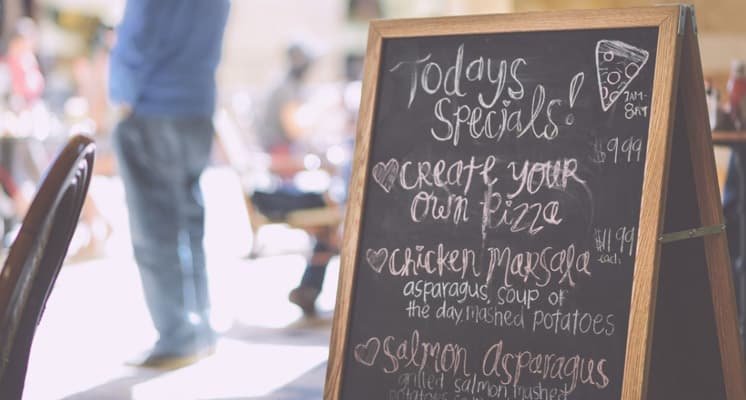
This is one of these things that can only be learned from experience. But in short, here’s the process:
- Order something that’s easy to “guestimate” the calories and macros off. For example, salmon with potatoes and remoulade sauce.
- Search up each of these foods in MyFitnessPal. I prefer doing this after the restaurant visit so that I’m not seeming too neurotic, becuase I’m not.
- Guestimate how much off each of these foods that were in your meal. For example, you might have estimated that you had 1 salmon fillet, 1 cup of potatoes and 0.2 cups of remoulade sauce, which from my experience is a typical size of a restaurant meal. Don’t forget to add some oil in there as well, as restaurants love using a ton of oil when cooking their food.
Here’s what this meal would look like in MyFitnessPal:
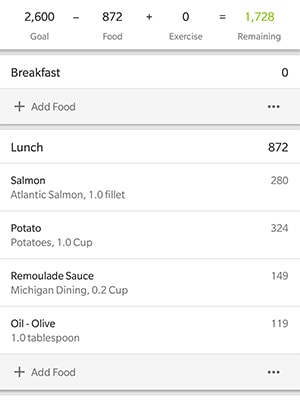
And here’s the macronutrient breakdown of this meal:
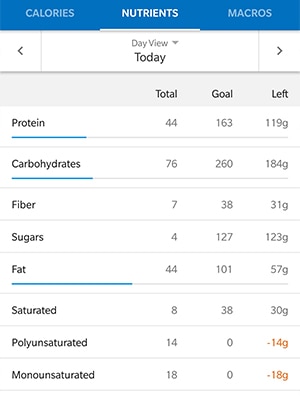
Don’t care to much about your carbohydrates and fat, protein intake is what you’re looking at.
Now, obviously this way of guestimating how much you’re eating from a mom and pop restaurant won’t be accurate, that’s why I call it a “guestimate”.
But here’s the thing, even if you “accidentally” eat 200 calories more on one day, you might “accidentally” eat 200 calories less the next day. Over the course of a week you’ll likely balance out the calorie intake and be more or less on track anyways.
Not only that, how much does it really matter if you lose 1 lb in a week or 0.7 lbs in a week if your goal is fat loss? Personally, I don’t care much, I will reach my goal physique eventually doing this anyways, if it takes a couple weeks longer, or a couple weeks shorter doesn’t matter as long as I can eat out when I feel like it.
So, do yourself a favor and don’t stress yourself up over not tracking correctly. Being flexible is the key for long-term success!
Step 3 – Take Advantage of Intermittent Fasting

Me having a cup of coffee instead of breakfast!
Intermittent fasting is a tool that I absolute love to use when traveling, especially for getting or staying lean. This is true for two reasons:
- Intermittent fasting makes it easier to stick within your calorie budget
- Intermittent fasting can help reduce the meal count making it easier to focus on more important things than dieting
Let’s cover these one by one:
1. Intermittent fasting makes it easier to stick within your calorie budget
When eating out, the biggest problem is usually that the meals you get is very high in calories. For instant, the Philly Cheesesteak Sub and the mom and pop salmon examples above both comes in close to 900 calories each.
And depending on your body size and daily activity you might only have room for 1800-2300 calories per day if your goal is to lose body fat.
By taking advantage of intermittent fasting, where you’re skipping breakfast, you could get away with both of these highly satisfying meals during the day, for a grand total of 1800 calories eaten. If you’re a person who needs to eat 1800 calories per day to achieve fat loss, you wouldn’t be able to do this if you had a breakfast of let’s say 500 calories.
If however you can eat 2300 calories you obviously would have room for the breakfast of 500 calories as well. But, this is where you have to ask yourself; what would I rather spend my calories on? Would I like a 500 calorie breakfast? Or would I rather save those 500 calories for later in the evening?
Personally, and especially when I’m traveling, I almost always save my calories for the evening. This is so that I can enjoy dessert or alcohol etc. during the evenings while still being in a calorie deficit.
Now what’s worth mentioning is that intermittent fasting is simply a dieting tool for budgeting calories to allow for bigger meals and more food later in the day. If you absolutely love the hotel breakfasts, then go for it! But just remember that you need to eat less during the day and evening by having the breakfast.
What about when I’m bulking?
When you’re bulking the strategy of utilizing intermittent fasting becomes less important. When you’re eating in a calorie surplus you need to eat a lot of food, which can make eating bigger meals more challenging. At this point eating something in the morning can be a good thing to spread out your calories making each meal smaller.
This is an individual thing though. Personally, I don’t have any problems eating 1300-1500 calories in one sitting, so for me intermittent fasting helps me to stay lean easier when I’m bulking.
Furthermore, since I tend to relax more when I’m traveling I want to ensure that I’m not putting on too much body fat when bulking, and intermittent fasting truly helps with this.
2. Intermittent fasting can help reduce the meal count
For me this is golden. I love to just grab a coffee, get out on my adventures in the morning and don’t think about food. Then follow this up with 2 large meals during the day and evening, and then save a few calories for a treat at night.
Personally, I view this as dieting freedom where I get in shape not having to think about the diet much at all, yet it still allow me to enjoy big and satiating meals and treats throughout the later part of the day.
Step 4 – Don’t Overeat Junk Food
The last step surrounding the diet while traveling is to not overeat on junk food. If you base the majority of your food intake around low-quality, non-nutritious foods you will eventually start feeling lethargic and sluggish.
The way to avoid this is by picking healthier food when eating out. Make sure that as many meals as possible include vegetables, sallads and fruits and that you’re not eating a ton of refined sugar and fats.
I’m always sticking to the 80/20 rule of dieting, where 80% of my diet should be made up of wholesome, nutrient dense food, and the remaining 20% can be low quality junk food. For instance if I’m eating around twenty meals per week, four of these meals can be complete junk without resulting in any negative outcomes.
If you want to learn more about including junk food in your diet and still succeed, check out these posts next:
How to Set Your Training While Traveling
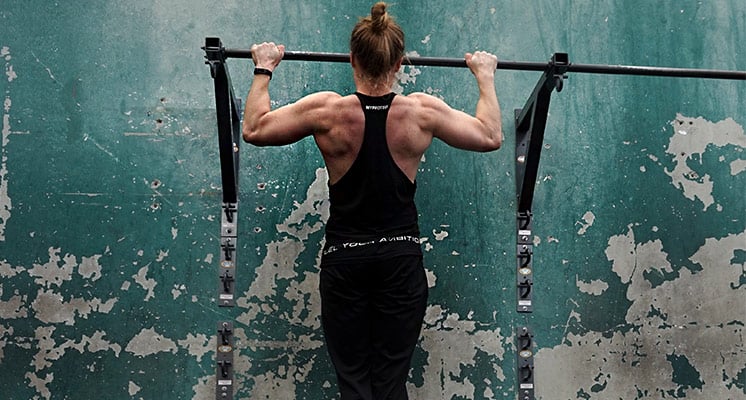
Okay, so let’s get to the second part of the equation, which is training.
In order to build a ripped physique, training is extremely important. But, the biggest struggle when traveling is that training can easily become less of a priority, simply because it can become a hassle sometimes if the place you’re visiting don’t have a gym.
But, this is easily fixed with some planning ahead, with a flexible mindset and the skillset ready to crush it no matter your situation. So, let’s look at these.
1. Plan Ahead – What Type of Training Will You Have Available on Your Trip?
If you know beforehand where you’re going then take some time to research the area. Do the area have a gym that you could visit? Do the area have no gym, but it has an outdoor gym or a park?
From this research you can be prepared on what kind of training you need to do before you’re going. If the area do have a gym that you can access, then you will likely be able to do regular gym exercises like bench presses, rows, pull-ups, overhead presses etc.
But, if the area have no gym, then you will have to make use of bodyweight training, which when done right can effectively transform your physique!
2. Focus on The Most Bang For Your Buck Exercises
No matter what type of training you’ll need to do when away, make sure you learn to use the most effective and efficient exercises out there for packing on strength and muscle mass.
The reason why you want effectiveness and efficiency is that you likely won’t allocate the same time towards training as you would at home. At least this is true for me personally. When I’m away I want the training to be quick and effective so I can spend more of my time enjoying my traveling. For this reason I always focus on minimalistic training when away.
So, what are the most bang for your buck exercises?
Most bang for your buck gym exercises:
If you’re going to have access to a gym, then these are hands down the best exercises to focus your energy on:
- Incline Bench Press (barbell and dumbbell)
- Overhead Press (barbell and dumbbell)
- Squats (Leg press if you’re not built for squatting)
- Deadlifts, regular or Romanian
- Weighted Pull-ups (Pulldowns if you can’t do Pull-ups)
- Cable Rows (wide grip and close grip)
- Dumbbell Lateral Raises
If you want to learn more about why I recommend these exercises, read this post next.
Most bang for your buck bodyweight exercises:
If you won’t have access to a gym, then these are the best bodyweight exercises to focus your energy on:
- Push-up varaitions (regular, feet elevated, one-arm)
- Pull-up variations (supinated, pronated, neutral, muscle-ups, one-arm)
- Handstand Push-up variation (agains wall, pike, parallettes)
- Pistol squats
- Hanging leg raises & Front leavers
If you want to learn more about bodyweight training and these exercises, read this post next.
3. Focus on Full Body Workouts – 2x Per Week is Enough
To really save time, yet at the same time get a great stimulus for growth, you should focus on full body workouts. By doing so you can get away with training only twice per week.
Here’s how your traveling workout routine might look depending on whether you got access to a gym or not:
Traveling Gym Routine
Traveling Gym Workout A – Full Body
- Squats (or leg press) – 3 sets x 4-12 reps
- Incline Barbell Bench Press – 3 sets x 4-12 reps
- Weighted Pull-ups (or pulldowns) – 3 sets x 4-12 reps
- Overhead Press – 3 sets x 4-12 reps
- Cable Rows – 3 sets x 4-12 reps
- Dumbbell Lateral Raises – 3 sets x 12-17 reps
Traveling Gym Workout B – Full Body
- Deadlifts (regular or Romanian) – 3 sets x 4-12 reps
- Weighted Pull-ups (or pulldowns) – 3 sets x 4-12 reps
- Incline Barbell Bench Press – 3 sets x 4-12 reps
- Cable Rows – 3 sets x 4-12 reps
- Overhead Press – 3 sets x 4-12 reps
- Dumbbell Lateral Raises – 3 sets x 12-17 reps
Workout Notes:
- Rest 2-3 min between sets and exercises.
- Train close to failure on each set. (Failure = you can’t do a rep more.)
- The reason why I put 4-12 reps is to give you room for training in either a lower or higher rep range depending on available weights in the gym.
Traveling Bodyweight Routine
Traveling Bodyweight Workout A – Full Body
- Pistol squats – 3 sets x Max
- Push up variation – 3 sets x Max
- Pull-up variation – 3 sets x Max
- Hanging leg raises – 3 sets x Max
- Handstand Push-up variation – 3 sets x Max
- Front Leavers – 3 sets x Max
Traveling Bodyweight Workout B – Full Body
- Pistol squats – 3 sets x Max
- Pull-up variation – 3 sets x Max
- Push up variation – 3 sets x Max
- Hanging leg raises – 3 sets x Max
- Handstand Push-up variation – 3 sets x Max
- Front Leavers – 3 sets x Max
Workout Notes:
- Rest 2-3 min between sets and exercises.
- Train to failure on each set. (Failure = you can’t do a rep more.)
- Make sure you train to your absolue max on each set (with good technique), as this is important when doing bodyweight exercises.
4. Keep Intensity High
To get the most effective and efficient training in while traveling make sure you’re training both with heavy weights/exercises and that you train close to failure.
By doing this your overall training volume and frequency (how much and how often you train) can be lower, yet you will see great strength and muscle gains.
So, make sure you train with intention and intensity!
5. Think Progressive Overload!
Last but definitely not least would be to do your best to train for progressive overload when you’re away! If you want to build a ripped physique you must consistently do more training overtime.
This could be more weight, more reps, more sets, shorter rest etc. Anything you can do to make your training more challenging overtime will lead to a more impressive looking physique.
If you want to learn more about the importance of progressive overload, watch this video:
Control Your Alcohol Consumption
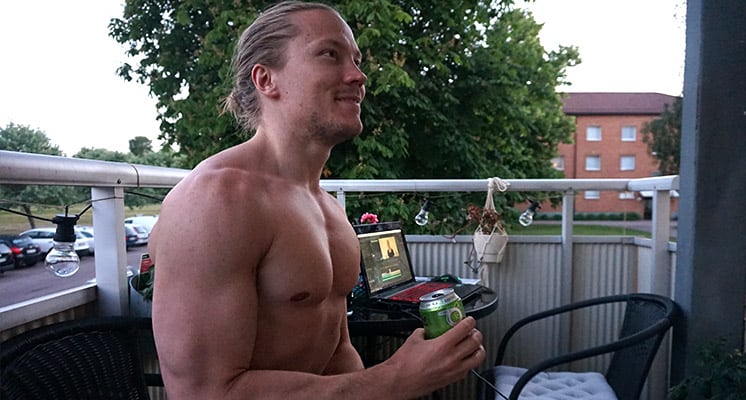
For many of us, alcohol is part of our lifestyle when traveling. As it should be!
The good news is that alcohol won’t interfere with muscle growth, neither will it stop fat loss, as long as you’re structuring your drinking smartly and drink in moderation.
Alcohol contain calories just like protein, carbs and fat, the difference is that alcohol calories are useless to the body. For that reason you need to control your intake if you want to build a ripped physique, and here’s how:
1. Save up on a calorie buffer to make room for alcohol
There are two things you can do here, and they work best in combination:
- On the day that you are supposed to be drinking, reduce your intake of fat and carbs a bit, and try to get the bulk of energy from protein. This is done by having mostly vegetables and lean protein sources earlier in the day.
- Utilize intermittent fasting. By skipping breakfast and possibly lunch, you’ll create a large buffer of calories to spend both eating and drinking in the evening. Remember, it all comes down to calories in vs calories out, and intermittent fasting will certainly help you buffer most of your calories so that you can enjoy yourself as much as possible.
2. Avoid alcohol sources that are rich in carbohydrates
Avoid drinks that include sugary sodas and fruit juices, also try to avoid beer. These kind of drinks includes a lot of carbs on top of the alcohol, meaning they have a very high calorie content. For example, one heavier type of beer typically contains ~200 calories.

Aim for dry wines (which are very low in carbs), whiskey, vodka, tequila, scotch, gin and cognac, all these include basically zero carbs.
If you don’t want to drink these straight, drink them with diet soda, as that’ll add zero calories, and research has shown repeatedly that Aspartame isn’t negative to our health.
Finally, don’t try to be super neurotic about this, drinks should be enjoyed after all. Just be aware that there are better and worse choices out there.
3. Drink in moderation
Avoid getting to the point where you become excessively drunk as you’ll lose judgment of your actions. When you’re drunk not only will you have an easier time saying “fuck it” and just eat it all, it’s also normal that when we’re getting drunk our hunger signals get all messed up, causing us to overeat on junk food that we don’t actually need.
In fact, beliefs such as; “alcohol makes you fat” are often just made up, people typically indulge in all the junk they see when drinking because of a loss of judgment and not because of the alcohol directly.
So, what’s a moderate alcohol intake?
Usually people start to tip over into the drunk realm somewhere after 3-5 “normal” drinks depending on body size. But, it’s hard to give any concrete recommendations on the amount you should consume, this is something you must figure out for yourself.
4. Avoid eating late at night
Again, the problem when drinking is what happens after all the alcohol. Burger King or McDonald’s are the usual go to, at least here in Sweden. And of course, if you’ve been slamming down 5 drinks and then push down 700 calories on top of this, you’re going to gain fat.
For this reason, I recommend that you avoid snacking after you’ve been drinking. Even if you’re having calories left in your budget, it’s extremely easy to get tempted to eat more when you’re tipsy on the alcohol. A much better option at this time would be to have a filling snack, such as a fruit or a protein bar. This usually reduces your cravings and will get you your judgement back.
If you follow these guidelines that I just outlined, you can have a few nights out every now and then without having to worry about gaining fat or ruining your muscle building progress.
With that said though, remember to drink responsibly or alcohol will quickly become negative to both your health and physique!
If you want to learn more about alcohol and getting ripped, read this post.
What’s Next?
There you have it, all the steps you should follow in order to get ripped while traveling.
Now, if you’re unsure about where to start and what kind of physique to aim for. Then I recommend that you read my completely free guide: How to build an aesthetic physique, which you can read for free here!
